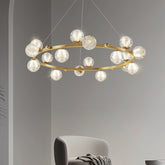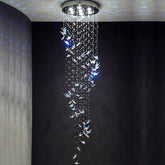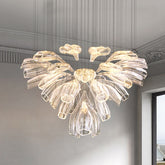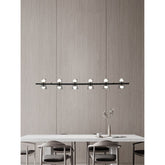Starry Nights and City Lights: A Beginner's Guide to Stargazing in Urban Areas
Welcome to the enchanting world of stargazing, where the cosmic ballet unfolds overhead, painting the night sky with celestial wonders. However, for urban dwellers, this pursuit comes with its own set of challenges. As city lights continue to cast their glow, the once-clear night sky becomes a canvas marred by light pollution, making it increasingly difficult for beginners to witness the full beauty of the cosmos.
In this guide, we embark on a journey to unravel the secrets of stargazing in urban environments—a quest to find clarity amidst the city lights. Beyond the glare of street lamps and skyscrapers, there lies a realm of twinkling stars and fascinating celestial phenomena waiting to be discovered. The key lies in understanding the challenges posed by urban living and learning how to navigate them effectively.
Understanding Urban Stargazing Challenges
Light Pollution and its Impact on Visibility
-
Definition and Types of Light Pollution: Imagine standing on the edge of a vast ocean, trying to appreciate its beauty, but someone shines a flashlight directly into your eyes. Similarly, light pollution is the urban stargazer's arch-nemesis—a collective glow from streetlights, buildings, and other sources that obscures our view of the night sky. It comes in various forms, from the intrusive glare of overbearing streetlights (skyglow) to the localized brilliance around commercial signs and outdoor lighting (clutter). Understanding these types is the first step in reclaiming our cosmic view.
-
Effects on Stargazing Experience: Light pollution isn't just an inconvenience; it's a veil that dims the brilliance of the stars and celestial wonders. It not only limits the number of stars visible but also hinders the observation of fainter objects like galaxies and nebulae. Beyond the aesthetic impact, excessive artificial light disrupts the natural circadian rhythms of both humans and wildlife. As we delve into urban stargazing, it's crucial to grasp the implications of this pervasive glow and discover ways to mitigate its effects.
Choosing the Right Location
-
Identifying Spots with Lower Light Pollution: Picture this: a quiet corner of your neighborhood where the stars emerge from the darkness with clarity. To maximize your stargazing experience, seek out locations with minimal light pollution. These hidden gems might be farther away from the city center or shielded from direct light sources by natural barriers. Embracing the challenge of finding these spots is a rewarding part of the urban stargazing journey.
-
Public Parks, Rooftop Terraces, and Other Accessible Locations: Not everyone has the luxury of escaping to remote stargazing sanctuaries. Fear not; urban stargazing is possible from the heart of the city. Public parks offer a reprieve from the luminous cityscape, providing pockets of darkness where constellations shine through. Rooftop terraces, with their elevated vantage points, can also offer unobstructed views. We'll explore these accessible havens where the city's glow takes a backseat to the brilliance of the night sky.
Essential Gear for Urban Stargazing
Binoculars and Their Importance for Beginners
-
Choosing the Right Binoculars for Stargazing: If telescopes seem like a cosmic leap, fear not—binoculars are your trusty sidekick in the realm of urban stargazing. Finding the perfect pair involves considering factors beyond just magnification. Opt for binoculars with a moderate magnification (7x to 10x) and a wide field of view to capture more of the night sky. Additionally, lens diameter matters; larger lenses collect more light, revealing fainter celestial objects. As we dive into the world of binoculars, we'll guide you through the selection process to ensure your stargazing experience is nothing short of stellar.
-
Binocular Astronomy Tips for Urban Observers: Armed with binoculars, urban stargazers can unlock a treasure trove of celestial delights. Learn how to scan the night sky systematically, identifying constellations, star clusters, and even distant galaxies. We'll explore techniques to steady your view, adjusting focus for optimal clarity. The cosmos is brimming with wonders visible through binoculars, and with a few handy tips, you'll be navigating the urban heavens like a seasoned astronomer.
Smartphone Apps for Stargazing
-
Overview of Stargazing Apps: In the age of technology, your smartphone can be your celestial companion. Stargazing apps bring the universe to your fingertips, helping you navigate the night sky with ease. From identifying constellations to locating planets, these apps offer a user-friendly interface for both beginners and seasoned skywatchers. We'll introduce you to some standout stargazing apps, each with its unique features, ensuring you have a cosmic guide right in your pocket.
-
How to Use Apps to Identify Constellations and Celestial Objects: Unlock the full potential of stargazing apps as we delve into practical tips for their usage. Learn how to align your device with the night sky, allowing the app to overlay constellations and celestial objects in real-time. We'll explore features that provide additional information about the wonders above, turning your smartphone into a powerful tool for urban stargazing. Whether you're a tech enthusiast or a traditionalist at heart, these apps can elevate your stargazing experience in ways you never thought possible.
Identifying Urban-Friendly Celestial Objects
Bright Stars Visible in Urban Areas
-
Highlighting Prominent Stars and Their Characteristics: Amidst the urban glow, certain stars manage to pierce through the luminous veil, captivating urban stargazers with their brilliance. We'll shine a spotlight on these celestial beacons, introducing you to stars like Sirius, Vega, and Betelgeuse. Learn about their unique characteristics, from colors to magnitudes, making them stand out against the city lights. Identifying these stellar actors is a key step in unlocking the beauty of the night sky in urban environments.
-
Tips for Star Identification Without a Telescope: Not everyone has access to a telescope, and that's perfectly fine! Armed with a keen eye and a few key tips, you can navigate the urban night sky like a seasoned astronomer. Discover how constellations can act as celestial roadmaps, guiding your gaze to specific stars. We'll share practical techniques for star-hopping and recognizing star patterns, allowing you to connect the dots and paint your own cosmic picture.
Planets Visible from Urban Locations
-
Overview of the Planets Visible with the Naked Eye: Planets, the wandering stars of our solar system, often steal the show in the urban night sky. We'll provide an overview of the planets visible to the naked eye, from the red brilliance of Mars to the majestic rings of Saturn. Understand their distinct characteristics, such as brightness and color, making them stand out against the backdrop of stars. With this planetary primer, you'll be well-equipped to spot these cosmic neighbors from the heart of the city.
-
Best Times for Planet Observation in Urban Environments: While planets grace the night sky year-round, their visibility varies. We'll guide you through the optimal times for observing each planet, taking into account their orbits and the changing seasons. Whether you're an early riser or a night owl, there's a planetary spectacle waiting for you. Plan your stargazing sessions to align with the prime moments when planets adorn the urban heavens, turning your cityscape into a planetary panorama.
Making the Most of Urban Stargazing Events
Timing Stargazing Sessions with Celestial Events
-
Meteor Showers, Eclipses, and Other Noteworthy Occurrences: Urban stargazing isn't just about the regular nightly spectacle; it's about catching the cosmic fireworks during special events. We'll highlight celestial occurrences like meteor showers, eclipses, and other rare phenomena that turn the urban night sky into a celestial theater. Learn when and where these events will unfold, ensuring you don't miss the chance to witness nature's grand celestial performances amidst the city lights.
-
Planning Ahead for Optimal Viewing: Successful stargazing in the city requires strategic planning. Discover the art of anticipating celestial events, from researching peak times for meteor showers to understanding the phases of a lunar eclipse. We'll provide practical tips for planning ahead, considering factors like moonlight, weather conditions, and the best viewing locations in your urban landscape. With a bit of foresight, you can turn any urban night into an extraordinary celestial experience.
Joining Local Astronomy Clubs and Events
-
Benefits of Community Engagement in Urban Stargazing: While the city may seem like an individualistic landscape, urban stargazers thrive when they connect with like-minded enthusiasts. Explore the benefits of joining local astronomy clubs and participating in organized stargazing events. From shared knowledge to the camaraderie of shared awe, community engagement adds a new dimension to your urban stargazing experience. Discover how collective enthusiasm can enhance your understanding of the night sky and foster a sense of belonging in the vast cosmic community.
-
Networking with Experienced Observers: Every urban astronomer starts somewhere, and joining a community allows you to tap into the wealth of experience held by seasoned observers. Learn from their insights, gain tips on navigating urban challenges, and expand your knowledge of celestial objects. Networking with experienced observers not only enriches your stargazing adventures but also opens doors to new opportunities, whether it's discovering hidden stargazing spots or collaborating on urban astronomy projects.
Tips for Enhancing the Urban Stargazing Experience
Using Light Pollution Filters
-
Overview of Filters and Their Benefits: In the battle against light pollution, filters emerge as powerful allies. We'll provide an overview of light pollution filters, explaining their types and how they work to enhance your urban stargazing experience. From broadband filters that selectively block out specific wavelengths to narrowband filters designed for specific celestial targets, each has its unique advantages. Understanding the role of filters is the first step toward reclaiming a clearer view of the cosmos amidst the city lights.
-
Installing and Using Filters Effectively: Once you've chosen the right filter for your urban stargazing endeavors, the next step is proper installation and usage. We'll guide you through the process of attaching filters to your binoculars or telescope, ensuring they become a seamless part of your stargazing toolkit. Additionally, learn techniques for adjusting filter intensity based on the urban lighting conditions. With the right filter strategies, you can unveil the hidden details of the night sky and transform your urban stargazing sessions into breathtaking cosmic experiences.
Adapting to Changing Weather Conditions
-
Strategies for Stargazing in Varying Weather: The night sky is a dynamic canvas, and weather conditions play a crucial role in urban stargazing. Explore strategies for observing through clouds, haze, and varying levels of atmospheric turbulence. Discover how different weather patterns affect visibility and learn when it's best to embrace the unique opportunities presented by ever-changing skies. By developing a weather-savvy approach, you'll be prepared to adapt and make the most of your urban stargazing experience, regardless of what the forecast predicts.
-
Preparing for Unexpected Weather Challenges: Urban stargazing comes with its fair share of meteorological surprises. From sudden rain showers to unexpected gusts of wind, be ready to tackle these challenges head-on. We'll provide practical tips for preparing your stargazing equipment for adverse weather, whether it's using protective covers or stowing gear quickly. Embracing the unpredictability of urban weather adds an element of adventure to your stargazing pursuits, making each session a unique and memorable cosmic experience.
Final Words
As we conclude our journey through the urban night sky, let's recap the key points that will empower you to embark on your stargazing adventures amidst the city lights. We've explored the challenges posed by light pollution and learned how to identify urban-friendly celestial objects. Essential gear like binoculars and smartphone apps has been unveiled as your companions in this cosmic quest.
We've discussed the importance of community engagement and the thrill of timing your stargazing sessions with celestial events. Additionally, we've equipped you with tips to enhance your experience through light pollution filters and strategies for adapting to changing weather conditions.
The beauty of stargazing in urban environments lies not just in overcoming challenges but in finding harmony between the celestial and the man-made. So, venture out into the night, fellow urban stargazer, and let the city lights be your backdrop to the grand cosmic theater. May your nights be filled with awe, inspiration, and a profound connection to the vast universe above.


































































































































